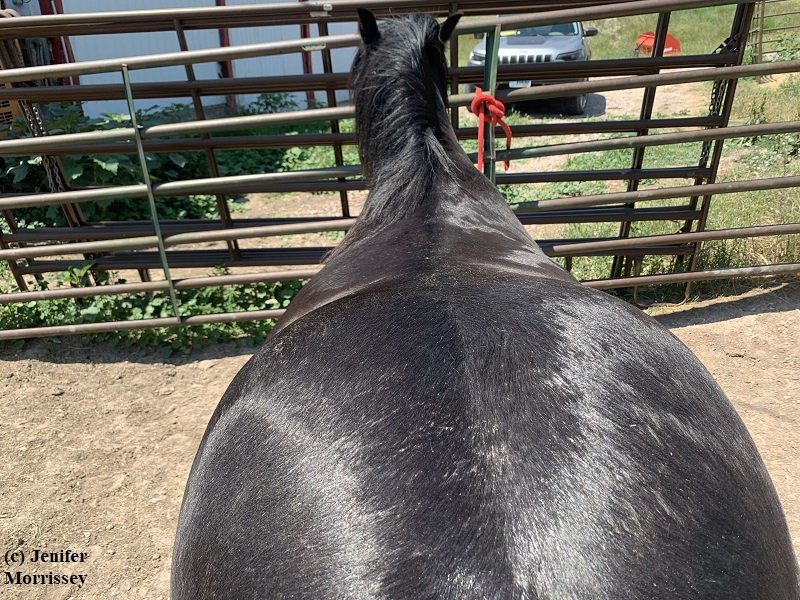Ideal Weight for a Fell Pony
/I got a question from a Fell Pony owner about the ideal weight for a Fell Pony. I love it when Fell Pony owners ask good questions! My first reaction was that ‘ideal weight’ is not a number. I know Fell Ponies as short as 12.2hh and as tall as 14hh or taller, so the ideal weight of any one pony will vary depending on their individual and unique stature. And their weight can and even should vary by season, as well as by work load and by age and by breeding status.
A barely visible valley down this Fell Pony mare’s back indicates body condition at the higher end of the preferred range.
When I bought my first pony, my mentor introduced me to checking for body condition. After reinforcing their lesson about ponies as easy keepers, they explained that you have to use your hands to assess fat covering because hair coats can make visual assessment inaccurate. Since then, I’ve seen numerous articles about how so many equine owners don’t recognize the body condition of their hooved partner. For my inquirer, then, I wanted to find and share a good body condition scoring website. When I did a quick search of the internet, though, I found not one but three sites that together provided what I felt was necessary information.
Body Condition Scoring ranks body condition numerically to identify the ideal fat coverage of an equine, rather than assign a particular weight in pounds as a target. In the US, the scores typically range from 1 (Poor) to 9 (extremely fat), with the adjectives thin, moderate, fleshy and fat in between. I have also heard of a scoring system in France that ranges from 0 to 5, with scoring often done in .25 increments.
On the 0-9 scale, I have personally seen Fell Ponies all the way from a score of 3 (thin) to 8 (fat). The pony scoring 3 (Withers, shoulders and neck accentuated) was a hard keeper for a Fell Pony. The pony scoring 8 (Crease down back. Difficult to feel ribs. Area along withers filled with fat. Area behind shoulder filled with fat, noticeable thickening of neck) was on very rich pasture. (The photograph here isn’t even close to what that pony was like; the crease or valley down its back was nearly an inch deep, compared to barely a quarter inch here.) And pasture isn’t necessary to create high body condition scores. My first Fell Pony mare was two hundred pounds overweight when I bought her, which was in January and she was being fed free-choice hay.
The first helpful website I found was one hosted by the feed company Purina. I appreciated this summary statement: “Most horses, including performance horses and growing horses, should be in a body condition score of 5-6. For optimum reproductive efficiency, broodmares should be a 5-7, and not allowed to lose condition such that they are below a 5 during breeding season. Horses over a condition score of 7 may be at a greater risk for developing metabolic disorders such as insulin resistance.” (1) Purina’s site (click here) has a diagram that effectively shows the areas of the equine that should be monitored for fat deposition (or not). There are good word descriptions of each score from 1 (poor) to 9 (extremely fat).
The second site that I found helpful was Texas A&M University’s (click here). This site had pen-and-ink drawings of each body condition score from 1 to 9. The advantage of drawings is that the artist can more easily draw our eye to key details than a photographer can. In this case, it is more obvious where the changes occur as you move up the scale from thin to fat. Also, this description is in PDF form so is easier to print if that’s something you like to do.
The final website from thehorse.com via the University of Kentucky (click here) describes how to actually score your pony’s body condition yourself. There are helpful photographs showing someone palpating each area of a horse’s body where fat deposition is common.
I don’t think determining ideal weight is any different for a Fell versus another equine, at least as far as body condition scoring is concerned. The most important thing for Fell Ponies is that they are given a time during the year when they lose weight down to a 3-4 score and then they can gain it back up to 5-7. It’s hard on us humans to let them lose weight and become thin, but it’s a completely natural cycle for them, since living out yearround as they’ve done for centuries on the fells of their homeland means gaining in the summer and losing in the winter. The key is that they need to lose weight at some point during the year. While keeping an equine at the same body condition yearround is what some experts recommend, I have had a veterinarian as well as veteran Fell Pony breeders say that the cycle of losing weight and gaining it back is natural and beneficial.
When it comes to body condition scoring my ponies, I often do it visually, which definitely has inaccuracies and disadvantages. When I do a physical examination, I use the fat covering over the ribs to check condition first, just because I have found that that area isn’t as easy to discern visually as, say, the area behind the withers. Checking the ribs in the winter months is especially important since the hair coat then obscures important detail.
So what is the ideal weight for a Fell Pony? It’s not a number of pounds. It is a healthy body condition for the individual pony in their individual living situation at a particular time of year. Mostly, determining our pony’s ideal weight is an opportunity to get to know our pony better, and, really, what could be better than that?!
1) https://www.purinamills.com/horse-feed/education/detail/body-condition-scoring-your-horse
© Jenifer Morrissey, 2022



